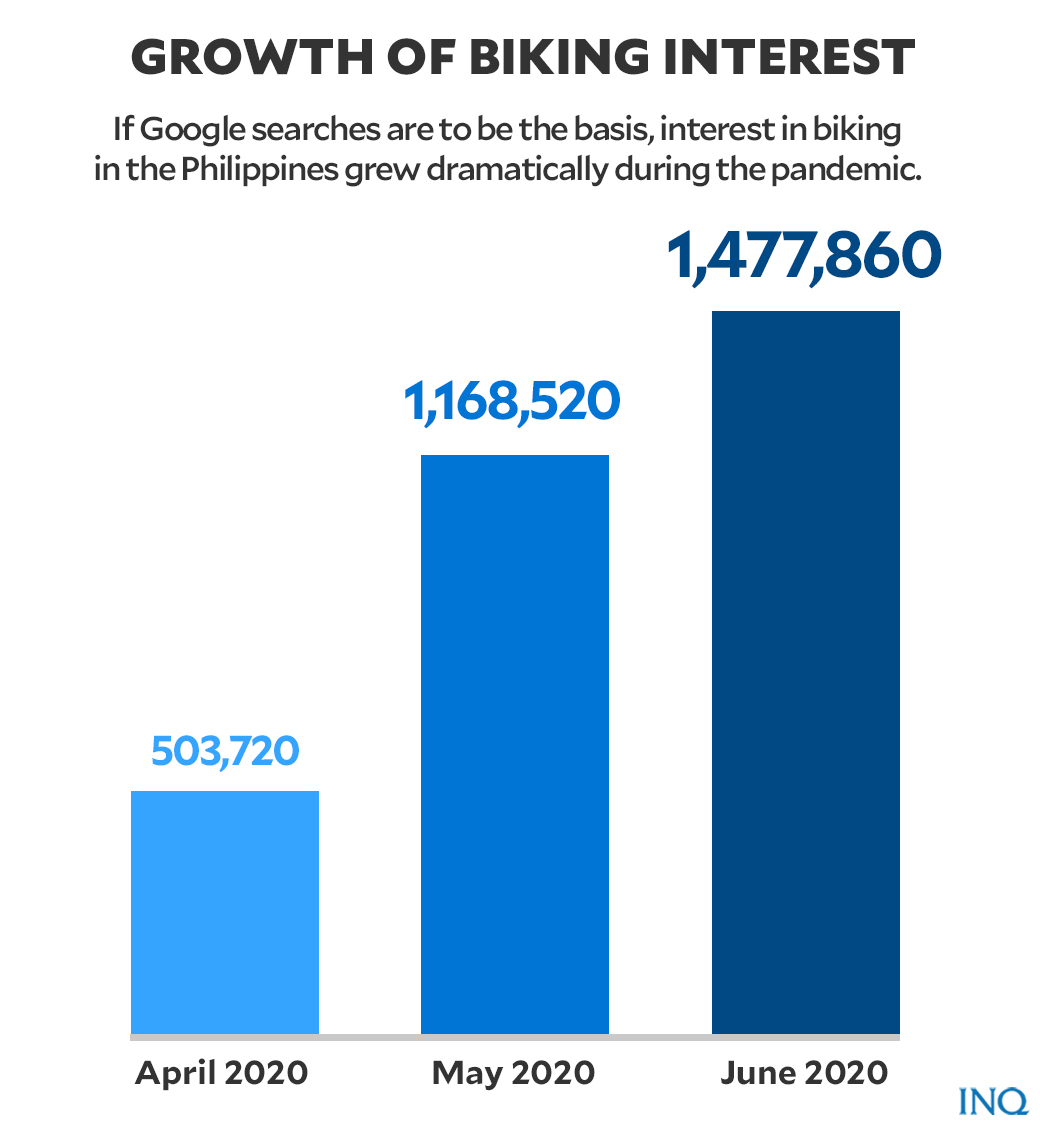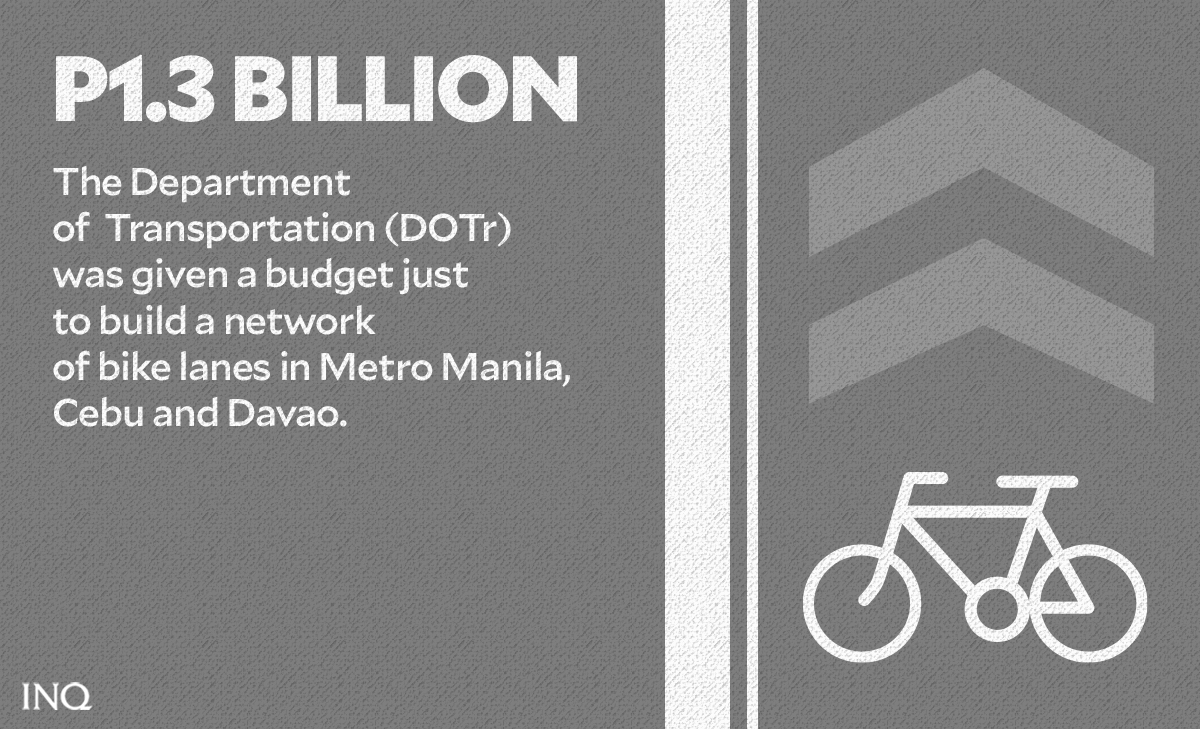Pedaling into the new normal: Bicycles take a slow, but expanding road in PH
MANILA, Philippines—The COVID-19 pandemic has opened the floodgate for a bicycle boom across the globe.
In 2020, the boom made its presence felt in the Philippines.
A study by the e-commerce aggregator iPrice Group showed an increasing interest in bicycles by Filipinos.
The volume of Google searches by Filipinos on bicycles, e-bikes and e-scooters continued to increase from January to March last year.

From 503,720 in April 2020, the number of searches for bicycles among Filipinos tripled to 1,168,520 in May of the same year. It further increased to 1,477,860 in June, a month after.
Article continues after this advertisement“The Philippine government has immensely limited the use of public transportation, which has left many public transport drivers and conductors at a loss,” according to iPrice.
Article continues after this advertisement“Hence, it makes sense how this year’s Google searches for bicycles is 163% more than last year’s, as commuters have more difficulty getting to work or buying essentials,” it added.
The study also said that most Filipinos looked for mountain bikes and road bicycles. The bicycle motocross or BMX was the Filipino’s third search subject.
Some were also exploring alternative and modern versions of bicycles.
“The Google search volume of e-bikes increased by a shocking 189% in May, while e-scooters increased by 151%,” the group said.
“Both vehicles prove to be good for the environment as it isn’t fueled by petrol, which is a huge plus for many consumers due to its long-term advantages in cost and environmental sustainability,” it said.
Higher demand, better sales
As interest in bicycles grew during the pandemic, sellers and distributors saw a surge in demand and sales in 2020.
In an article by the Philippine Daily Inquirer published in May 2020, Celeste Cycles, a 33-year-old cycling distribution firm with over 500 dealers nationwide, said stocks at the time sold out faster compared to pre-pandemic days.
Pandemic forces shift to pedal power
Ram Nieves III, owner of a small shop selling Japanese surplus bicycles, was also able to push his sales from 20 bikes in a “good month” before the pandemic to around 100 units by mid-April 2020.
More shops and distributors across the country had a similar experience last year.
COVID-19 pandemic: Filipinos turn to pedal power amid transport crunch
Road safety
Amid the emerging bike culture among Filipinos, bicycles were considered as an alternative mode of transportation in the new normal. However, concerns about road safety and bike lanes emerged.
In a Social Weather Stations (SWS) survey released last January, 87 percent of Filipinos said they prefer bicycles and public transportation to be given priority over private motor vehicles on roads in cities or municipalities.
87% of Filipinos want gov’t priority on public transport, bikes over private vehicles
According to freelance photographer and writer Lester Babiera—creator of First Bike Ride, an online community for cycling beginner—spacious sidewalks and protected bike lanes make roads safer for both bikers and pedestrians.
“Roads designed for pedestrians and cyclists are important. For me, they should be the priority when we build transportation infrastructure because they are the most vulnerable road users,” he said in an interview.
Wide sidewalks, bike lanes make cities safe
In 2020, House Bill No. 4493, or the “Bisikleta Para sa Kinabukasan (Bicycles for Tomorrow)” Act, was filed to create a national bike program and promote bike-friendly communities nationwide.
The bill seeks to establish the proper infrastructure to make biking in the country’s roads safe for all.
“Post-quarantine scenario, we see biking as the primary mode of transportation of our people owing to the limited public transport aimed at ensuring social distancing,” said Speaker Lord Allan Velasco, who authored the bill.
Last February, the Senate approved on third and final reading its own version of the bill seeking the establishment of “safe pathways” for those who prefer to walk, bike, or use other non-motorized vehicles to reach their destinations.
The bill mandates the Department of Transportation (DOTr) and the Department of Public Works and Highways (DPWH), in coordination with local government units (LGUs), to identify and create a network of bicycle lanes connected to essential destinations like workplaces, medical facilities or groceries, schools, banks, and others.
Bill creating ‘safe pathways’ for pedestrians, cyclists gets final Senate nod
Last May, the House committee on transportation approved a consolidated bill pushing for the establishment of a network of bicycle lanes and slow streets in the country.
House panel OKs bill creating bike lanes, slow streets
Several local government units (LGUs) have also implemented and introduced bike lanes in a bid to make roads and highways bike-friendly.
The local government of Pasig City started adding bike lanes and extended sidewalks as early as May last year.
It was the first local government in April to recognize biking as a necessary means of transport through Executive Order PCG-18 and City Council Resolution No. 59, which had substantial impact on those forced to work despite the ECQ during which all forms of public transport were banned.
Bike lanes were soon added on the streets and roads across Manila, Quezon City, San Juan, and Parañaque City.
Bike lanes to open near QC, Manila hospitals on Aug. 26
San Juan sets up bike lane, dedicated motorcycle lane on Ortigas Avenue
Parañaque fast-tracks bike, motorcycle lane project
Pop-up bike lanes, however, were prohibited by the Metropolitan Manila Development Authority (MMDA).
This came after Bikers United Marshalls (BUM), a bikers group, put up temporary barriers to protect cyclists on Commonwealth Avenue in June 2020.
MMDA spokesperson Celine Pialago, in an earlier statement, said the MMDA will sue the group for obstruction.
She added that bike lane protectors made out of plastic bottles were dangerous and “not enough to provide safety for bikers from speeding vehicles.”
MMDA to sue, slap P1,000 fine on bike group
The MMDA would, later on, announce that it will no longer file charges and slap fines against the cycling group but maintained that it would not tolerate any more pop-up bike lanes.
MMDA says no to pop-up bike lanes
‘Slow progress’
The Department of Transportation (DOTr) last November secured P1.3-billion to fund the installation of a bike lane network in Metro Manila, Cebu, and Davao as part of its pandemic recovery plan.
Cycling is about to get safer: The DOTr secures P1.3B to build bike lane networks
The budget was a portion of the P9.5 billion funding allotted by Congress to the DOTr under the Bayanihan to Recover As One Act.
However, cycling advocates in February slammed the transportation department over its lack of urgency in creating a protected bike lane network in the metropolis.
Cycling advocates slam gov’t delay in building bike lanes
By March, the DOTr reported that the national government has so far built 19 percent of the proposed 522.73-kilometer bike lane network.
On Tuesday (June 1), the department said that it was planning to finish the project by June 15.
According to its latest data, the DOTr said in Metro Manila, 270.23 kilometers of the target 338.53-kilometer bike lane has already been completed.
Outside the capital, 105.09 kilometers and 46.13 kilometers of bike lanes in Metro Cebu and Metro Davao have also been completed.
This means 427.44 kilometers of the 522-kilometer bike lanes in the three regions have already been built.
Road accidents
The need for bicycle-friendly roads was highlighted as the number of bicycle-related accidents ballooned in 2020.
According to MMDA’s Metro Manila Accident Reporting and Analysis System (MMARAS), there were a total of 3,026 accidents last year involving bicycles, e-bikes, and pedicabs.
It accounted for 2.4 percent of the total number of road accidents that year.
The latest number was nearly double the number of bicycle-related accidents in 2019, which was 1,759.
Cycle for better health
Cycling, whether for leisure, exercise, or transportation, provides numerous health benefits.
Citing several studies, the European Cyclists’ Federation (ECF) said cycling can help prolong life and contribute to a healthier lifestyle.
ECF added that cycling can help prevent a large number of severe and chronic illnesses, like cardiovascular diseases, type 2 diabetes, breast cancer, colon cancer, and osteoporosis.
Biking also provides mental health benefits and helps reduce the risk for Alzheimer’s disease by 29% and for cognitive decline by about 26%.
“Physical activity was also linked to 17% lower odds for developing depression in a large meta-analysis of relevant studies,” the organization said.
A 2010 study by Ingrid Hendricksen, Monique Simons, Francisca Garre, and Vincent Hildebrandt examined the association between commuter cycling and sickness-related absence in work.
Results of the study showed that employees who cycle to work regularly have on average 1.3 days less sickness absence per year.
“Cycling to work is associated with less sickness absence. The more often people cycle to work and the longer the distance traveled, the less they report sick,” the researchers said.
The University of Montana attributed the following health benefits to regular cycling:
- Burns calories and defines muscle tone
- Builds strength
- Improves balance and coordination
- Builds endurance and stamina
- Increases flexibility
- Improves joint mobility
- Reduces stress levels and risk for anxiety and depressions
- Improves overall mood and promotes productivity
- Increases blood flow, oxygen, and nutrients to the brain


